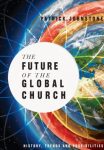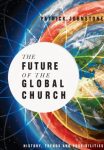Patrick Johnstone is best known as editor of the first six editions of Operation World, a prayer guide for Christians interested in fulling the Great Commission (Matthew 28:16–20). Now in its seventh edition, and edited by Jason Mandryk, Operation World presents data on the geography, peoples, economy, politics, and religion of the regions and countries of the world, which is drawn from sophisticated databases maintained by WEC International, an interdenominational missions agency. This data helps readers pray intelligently about the needs of those regions and countries throughout the year.
In The Future of the Global Church, Johnstone has drawn on those databases to create succinct narratives about and visualizations of the growth of global Christianity. The book can best be described as an historical atlas of the past, present, and possible future of world Christianity. It is a helpful resource for readers who want a concise presentation of the relevant information.
Johnston divides his material into nine chapters. Chapter 1 describes nine global challenges currently experienced around the world: population growth, migration, urbanization, pandemics (such as HIV/AIDS), climate change, income inequality, sustainable energy, political and social freedom, and water resources. Throughout the book, he highlights how environmental challenges such as these affect the movements of people—physically, intellectually, and spiritually—both in the past and at present. Doing so reminds readers that the course of history is not shaped merely by human thought and action. Larger forces are at work (such as natural disasters, pandemics, and birthrates), shaping the context in which people receive and propagate religion and nonreligious ideas and practices.
Chapter 2 summarizes the global growth of Christianity from its first-century origin to the present. Each of Christian history’s twenty centuries is summarized on two pages (except the twentieth century, which receives more extended treatment). These pages present maps depicting the faith’s global growth, tables summarizing relevant demographic information, and bulleted lists summarizing major events in the world at large and the church in particular. For readers interested in a quick summary of Christian history, this chapter is invaluable.
Chapter 3 identifies six major streams of Christianity. Listed in descending order by size, they are Christian (32.5 percent of global population as of 2010), Muslim (22.6 percent), non-religious (14.8 percent), Hindu (13.7 percent), Buddhist (6.5 percent), and ethnic/other (10 percent), the last category including religions such as animism, Sikhism, and Judaism (65). Johnstone provides several pages of data and visualization for each religious stream on succeeding pages.
Chapter 4 then turns its focus to the Christian stream. Johnstone divides Christendom into six megablocs: Catholics, Orthodox, Protestants, Anglicans, Independents, and Marginals, by which he means “[a]ny group that claims to be Christian but displays one or more of the following characteristics,” characteristics that focus on heterodox doctrine, non-biblical sources of revelation, and extreme sectarianism (114). Johnstone predicts that in the future, Christian growth will slow “due to the slowing of population growth” generally, but also that “Christian areas [such as Europe and North America specifically] will see their majorities eroded by secularism and diluted by non-Christian immigration.” This will be offset, however by “continued growth in Africa and Asia—especially China, India and [Southeast] Asia.” And Johnnstone predicts that there “are likely to be increasing numbers of conversions to Christianity in some countries with large Muslim populations,” Islam being the chief religious competitor to Christianity globally (118).
Chapter 5 examines “renewal movements” in Christianity, which Johnstone divides into three broad categories: Evangelicals, Pentecostals, and Charismatics. Evangelicals are “characterized by a theology based on the inerrancy of the Bible, a personal experience of salvation by faith through grace and a desire or obligation to witness to that salvation” (121). Given this definition, all Pentecostals are evangelical, and most Charismatics are. Elsewhere, Johnstone defines Charismatics as “those who testify to having had a renewing experience of the Holy Spirit and who exercise the gifts of the Spirit, such as speaking in tongues, healing, prophecy and miracles” (xii). Given this definition, all Pentecostals are charismatic. What distinguishes Pentecostals and Charismatics is largely denominational affiliation. The rapid growth of these movements is noteworthy and will likely continue well into the future. “If present projections prove accurate, by 2050 charismatic Christians will comprise one-third of all Christians and one-tenth of the world’s population” (125). This is remarkable growth, given that however one dates the history of modern Pentecostalism, by 2050 it will only be approximately 150 years old.
Chapter 6 outlines the history, growth, and geographic distribution of Evangelicals Evangelicalism in its many forms (including Pentecostals and Charismatics) provides “the main thrust for world evangelization” today, Johnstone contends (139). One of the most notable trends among the world’s Evangelicals is the demographic shift from North to South. As a share of regional population, Evangelicals are declining in Europe, North America, and the Pacific, but growing exponentially in Africa, Asia, and Latin America.
Despite the fact that Christianity is the largest religious stream globally, and that the most evangelistic components of that stream are its fastest growing segments, major regions of the world still exist without effective evangelization efforts by Christians. The unevangelized are the focus of chapter 7. “In the 1990s,” Johnstone writes, “5% became accepted as the dividing point between ‘unevangelized’ and ‘evangelized,” by which he means 5 percent of the population that “professes Christianity” in some form. He concedes that this is an inadequate definition, but it is nevertheless illustrative of the challenge of evangelization. Using that definition, in 2008 numbers, 2.5 billion of the world’s inhabitants are unevangelized because their people group consists of 5 percent or fewer Christians. Another 2 billion inhabitants live in people groups where Christianity is a statistical minority. And approximately 2.3 billion live in people groups where Christianity is a statistical majority (172).
Chapter 8 then turns to a consideration of what kind of missionary resources are necessary for the world’s people groups to be effectively evangelized. Unfortunately, there is a mismatch between the number of missionaries serving each of the six religious streams. Most missionaries serve in countries or regions where Christians constitute the majority of the population. Thus, 43 percent of Christians serve in Christian-majority countries. In descending order, 17 percent of missionaries serve among the ethnic religions, 15 percent among Hindus, 9.7 percent among Buddhists, 8.1 percent among Muslims, and 7.2 percent among the non-religious (231). The disparity is especially noteworthy with regard to Muslim-majority countries or regions. Though Muslims constitute the second-largest bloc of religious persons worldwide (after Christians), missionaries to Muslim-majority countries constitute the second-smallest bloc of total missionary personnel. Clearly, that needs to change if effective evangelization is to take place.
Johnstone concludes The Future of the Global Church by quoting the Commitment of the Third Lausanne Congress on World Evangelization, which took place in South African in 2010:
Let us keep evangelism at the centre [sic] of the fully-integrated [sic] scope of all our mission, inasmuch as the gospel itself is the source, content and authority of all biblically-valid [sic] mission. All we do should be both an embodiment and a declaration of the love and grace of God and his saving work through Jesus Christ (239, emphasis in original).
Given the data Johnstone has presented to this point, the Lausanne exhortation provides the exact right exhortation with which to end the book.
 Book Reviewed
Book Reviewed
Patrick Johnstone, The Future of the Global Church: History, Trends and Possibilities (Downers Grove, IL: IVP Books, 2011).
P.S. If you found my review helpful, please vote “Yes” on my Amazon.com review page.

